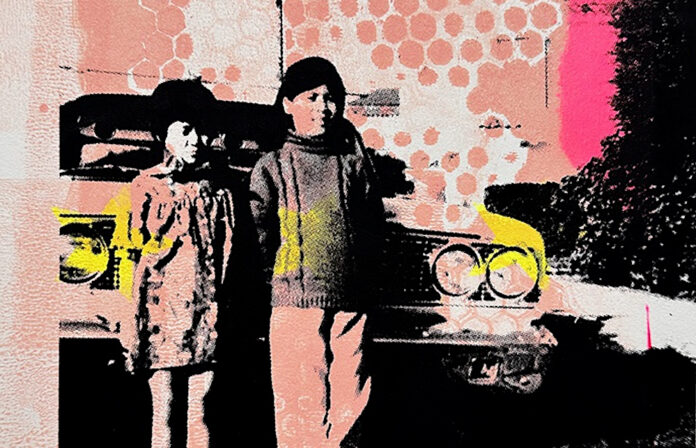In work that is simultaneously introspective and transformative, mixed-media artist Julia LaChica works in layers of materials and memories in homage to the collective journey. Her monoprints, paintings, and sculptural altars reveal her own story vis-à-vis a broader cultural dialogue.
LaChica first dipped her toe in the arts through printmaking in the 1980s when she took a block printing class at Mission Gráfica, based in the Mission Cultural Center in San Francisco. Around the same time, she began experimenting with assemblage and selling some of her work through Galería de la Raza’s Studio 24. For practical reasons, she studied Industrial Design at California College of the Arts (BFA 2002), attending both the San Francisco and Oakland campuses.
“For 20 years, I worked in houseware design while trying to keep my personal art practice alive. Now, I’m finally able to dedicate myself fully to my artwork, which has been both liberating and terrifying—but mostly, it feels like stepping into a space that was always meant for me,” LaChica told 48hills.
LaChica says she grew up surrounded by the complexities of immigrant life in an urban milieu where multiple generations squeezed into small apartments. She recalls the aromas from neighbors’ kitchens overlapping and wafting through the hallways.
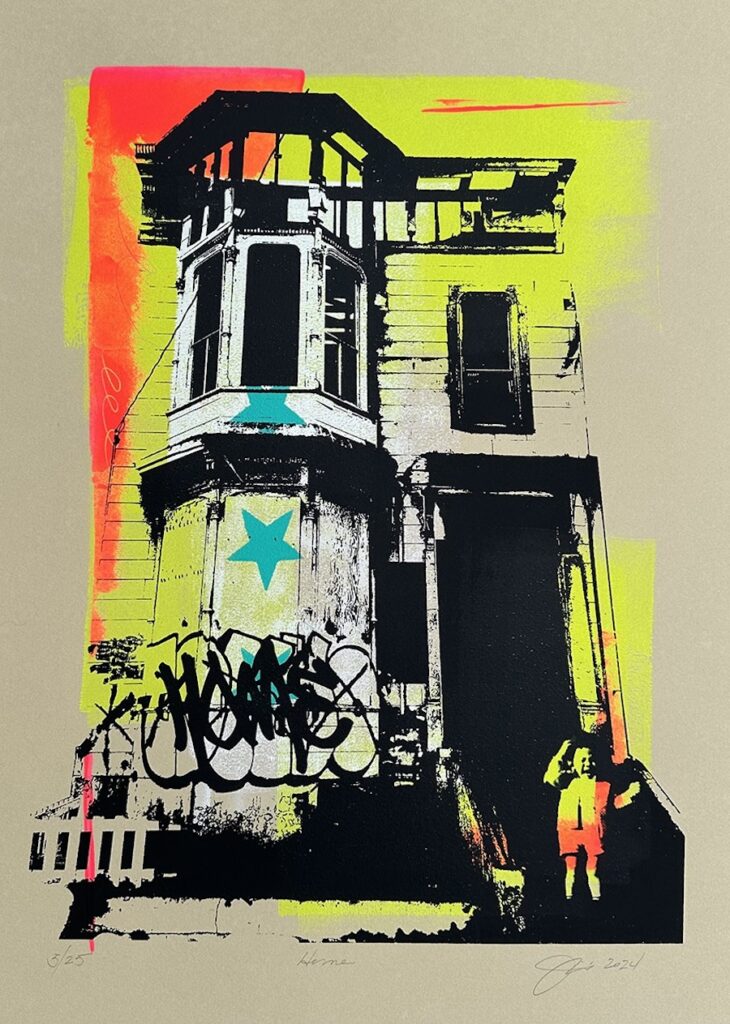
“I’m a queer daughter of a Japanese mother and Filipino father, born in San Francisco in 1963. When I was three, my family and I lost our Western Addition apartment to a fire and moved to Chinatown’s public housing project, Ping Yuen—’The Ping’ we called it,” LaChica said.
As a young adult, she lived and worked in the Mission District, where she became immersed in the local art scene, community activism, and the queer women’s community. LaChica has been living in Oakland’s Laurel District for the past 16 years with her wife Luella and their two dogs Ernie and Katsu.
“That time in San Francisco was pivotal in shaping my identity as both an artist and an advocate. The Mission was alive with muralists, printmakers, musicians, and spoken word artists, and I soaked in every bit of it,” she said.
LaChica says she loves the Bay Area’s art community because it’s built on deep relationships, solidarity, and a shared commitment to social justice. “The artists here are not just creating for galleries. They’re creating for movements, for healing, for resistance. That’s the kind of community I want to be part of,” LaChica said.
She is drawn to artists who infuse their work with history, memory, and resistance, citing Hung Liu, Frida Kahlo, Betye Saar, Jean-Michel Basquiat, Amalia Mesa-Bains, and Ai Weiwei as influences on her work.
“I also find inspiration in lesser-known but equally powerful artists: urban screen printers, Oaxacan Zapotec printmakers, Japanese artisans, and Filipinx tattoo artist Whang-Od. I love how art can be a form of storytelling, a way to pass down knowledge and preserve histories that might otherwise be erased,” LaChica said.
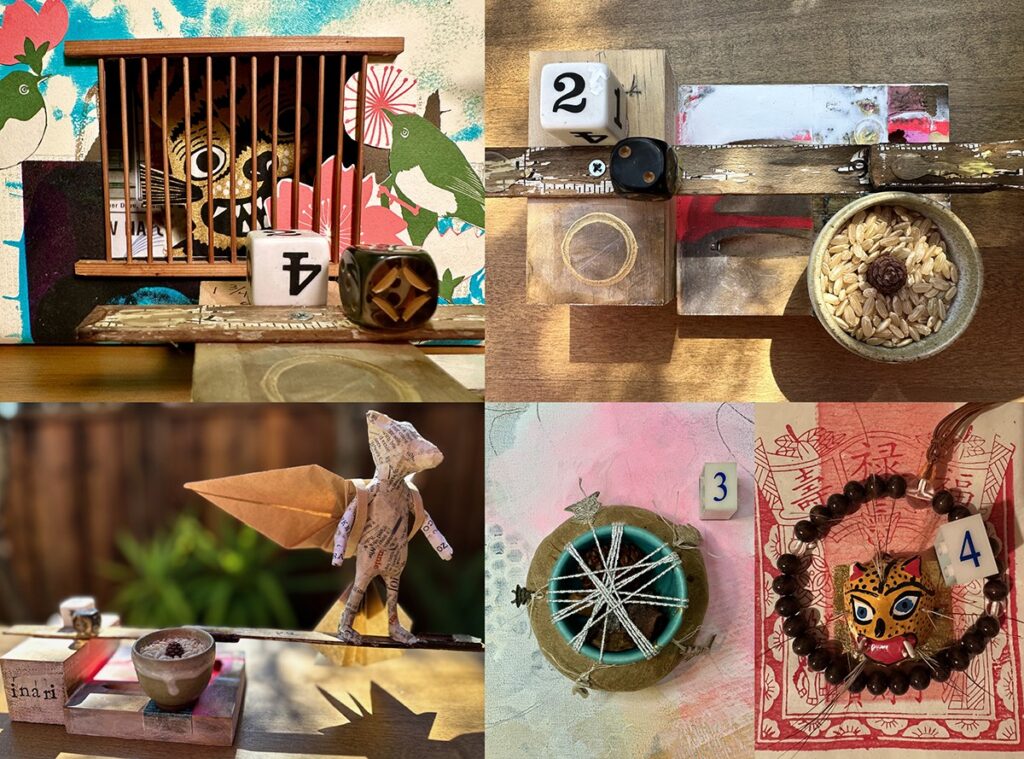
She adds that she is especially moved by the struggles and triumphs of working-class and immigrant communities. LaChica holds a deep respect for those who fight for dignity in the face of displacement, poverty, and systemic injustice. She believes this is why she often gravitates toward themes of home, belonging, and survival in her work.
“My work is rooted in memory—both personal and collective. I explore how objects, textures, and materials hold histories, using the media of painting, printmaking, collage, and assemblage. Found materials are a big part of my process because they already carry stories. I distress surfaces, layer paint, and incorporate elements like rust, fabric, and paper to evoke the passage of time,” she said.
A recent installation, Everyone Deserves a Place to Rest, shown at the Richmond Art Center’s Home Show in 2024, was a multi-media piece addressing housing insecurity and the human right to rest and as a direct response to the housing crisis. LaChica says that the pandemic, social uprisings, and her own transitions have sharpened the focus on themes of displacement, resilience, and communal care.
“That project felt personal because my own family has experienced housing instability, and I wanted to create something that would make people stop and reflect on what it means to have—or not have—a place to call home,” LaChica said.
Her Oakland studio, where she has been working for the past five years, is a blend of structure and open air: one-part outdoor patio, where water trickles from a clay pot and bamboo fountain, and one-part compact workspace (about 100 square feet) bathed in natural light from a skylight. DIY wooden French doors provide just enough shelter from wind and rain in the winter months.
“Inside, it’s a balance of organized chaos with stacks of materials, paint-stained rags, and half-finished pieces waiting for their next layer,” she said.
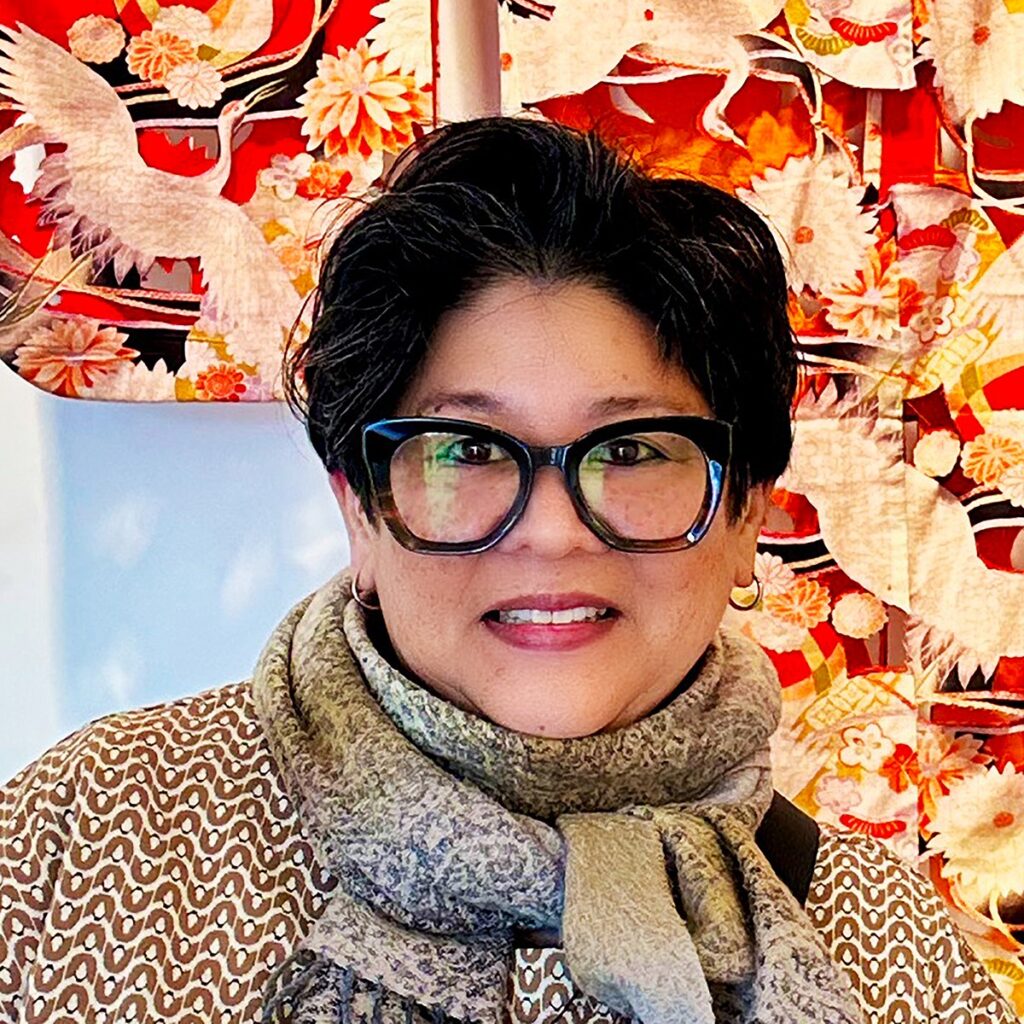
LaChica’s process is intuitive. She begins with an idea, a found object, or a fragment of memory, and then allows the materials to guide her. On any given day, she might collage over a painted surface, sand it down, add marks, remove something, then repeat the process.
“Each step is a conversation between the layers. Some days are about movement and energy, other days are about stepping back, observing, and listening to what the piece is asking for,” she said.
For LaChica, a piece feels complete when it carries “the right amount of weight” and when the textures, colors, and layers have fully revealed the story they were meant to tell.
For years, LaChica said, her art lived in the margins of her life. She tended to her practice whenever it was possible to do so between responsibilities. Since leaving her full-time design job, she has been able to go deeper, experimenting with diverse materials, integrating installations, and refining her visual language.
“A turning point for me was my solo exhibit in 2011 at the Manilatown Heritage Foundation in San Francisco, where I explored Filipino migration, labor, and diaspora. That show made me realize how much I want my art to serve as an archive for untold histories,” LaChica shared.
Though her work has always centered around justice, in recent years, it has become more immersive, participatory, and multi-layered while offering not just observations and critique but also space for healing and connection, she says.
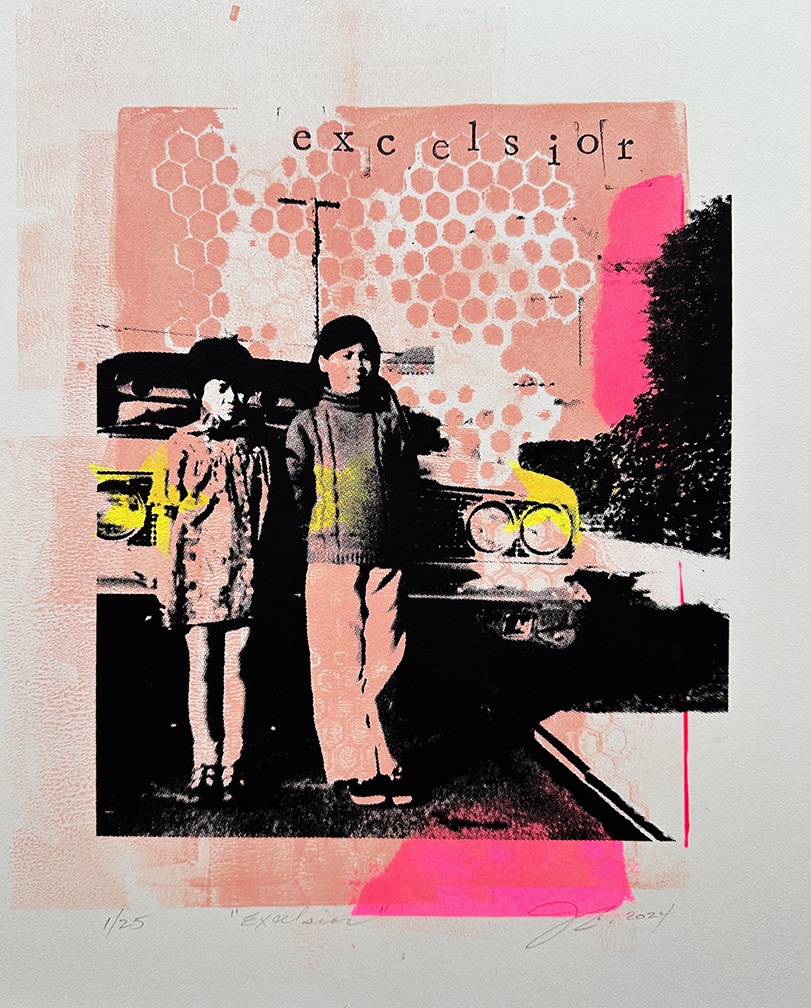
“The world is changing, and so is my practice. The urgency of our times is woven into my work but so is hope and the belief that through art, through community, through storytelling, we can build something better,” LaChica said.
LaChica’s latest work is a mixed-media installation called A Promise Unspoken. The artist says it’s a deeply personal piece about caregiving, resilience, and identity centered around her mother’s journey, while also reflective of larger narratives within the Asian American/Pacific Islanders (AAPI) community.
“The central painting titled Memories & Obstacles, tells a story through movement and time. The figures are arranged diagonally: my mother, walking slowly with a cane; me behind her, pushing a wheelchair; and, further ahead, her younger self in her wedding kimono. This creates a visual and emotional arc, that speaks to transformation, memory, and shifting roles,” LaChica said.
The color choices are intentional. Approaching it symbolically, LaChica uses highly saturated black and sepia tones that contrast with bursts of neon orange, representing the tension between memory and presence, the weight of time and the quiet shifts that occur, and the vibrancy of fleeting moments.
“Walking behind my mother, I feel the role reversal—once cared for by her, now I support her. Meanwhile, she moves toward her past self, dressed in her wedding kimono, almost as if she’s drawn back to the life she once knew. That moment where past and present nearly touch captures the essence of who she was, who she is, and how those versions of her exist simultaneously. The neon acts almost like a flash of recollection—sudden, intense, and deeply felt,” LaChica said.
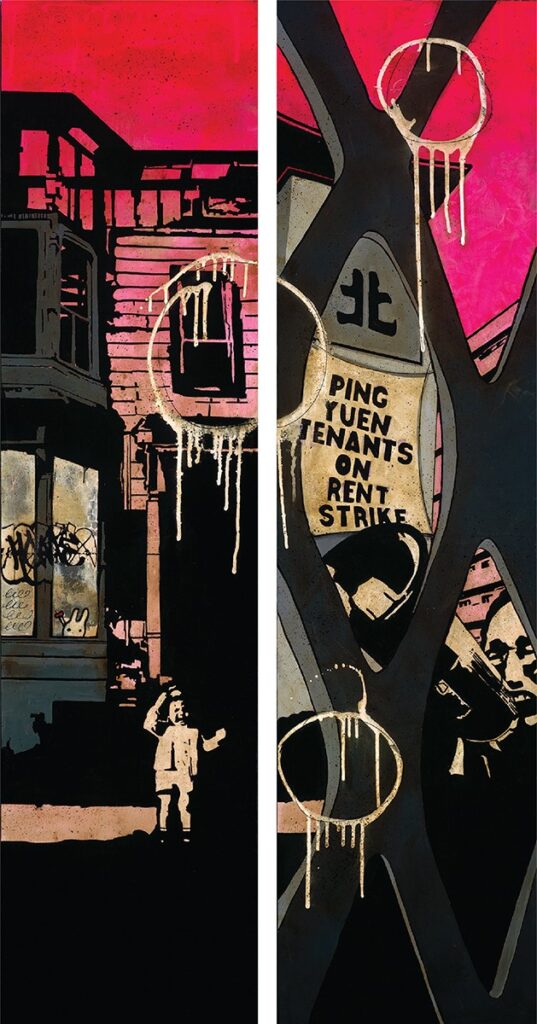
Recent exhibitions include Mendings and Marvels at Arc Gallery & Studios, which closed on July 12, and BROWN PALMS, YELLOW BALMS: Reinventing Caregivers of Color, co-sponsored by the American Asian Women Artist’s Association (AAWAA) and the Asian Pacific Islander Cultural Center as part of the 28th annual United States of Asian America Festival 2025: Critical Refuge, curated by O.M. France Viana. The exhibit was presented at SOMArts in April/May 2025.
LaChica was included in juried group exhibitions, Family Portrait, at the Museum of Northern California Art (MONCA) in Chico, California, from March through May 2025, as well as San Francisco On Paper, an exploration of the geography, evolution, and history of the city, at The Drawing Room in the Mission earlier this year. LaChica also teaches printmaking workshops at the Richmond Art Center, helping people share their stories through art.
Art and activism are deeply connected for LaChica, who recollects the times she has marched in the streets, drum in hand, shouting for justice and freedom. She has designed custom screen prints for BoomShake, a Bay Area drumming collective for women, trans, and the nonbinary community who bring rhythm and resistance to protests. She also plays drums in two bands: Umami Funk and The Chi Chi.
“We do a mix of covers and original music, but you won’t find our stuff online because we mostly play for ourselves. It’s kind of like karaoke—just for the pure joy of it. As my wife says, people think you have to be a professional musician or play gigs to experience the rush, camaraderie, and fun of making music together. But we just do it, and honestly, we’re pretty good,” LaChica said.
As mixed-media artist Julia LaChica continues to unravel and share her personal journey, uncovering the past while helping to shape and re-shape the future, she hopes to touch others as they ponder their own life stories.
“I want people to feel something—whether it’s recognition, discomfort, nostalgia, or urgency. I want my work to serve as a bridge between personal histories and larger social issues,” she said. “Art isn’t just about creating, it’s about remembering, reclaiming, and resisting. We all have stories worth telling. If you feel like your voice doesn’t matter, remember that history is shaped by those who refuse to be erased. Keep making, keep telling, keep fighting.”
For more information, visit her website jlachica.art.

